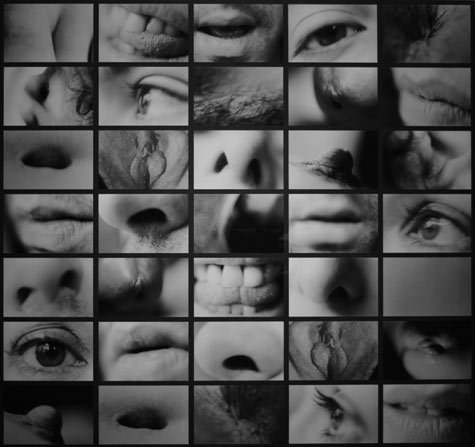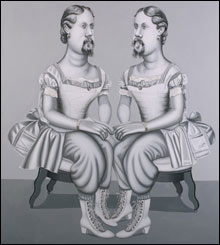
PORTRAIT PARTIALS: Carolee Schneemann’s catalogue of holes and orifices raises questions
about the objectification of bodies. |
“Carolee Schneemann” Pierre Menard Gallery, 10 Arrow St, Cambridge | Through November 25 | “Hannah Barrett: The Secret Society”
Howard Yezerski Gallery, 14 Newbury St, Boston | Through October 30 | “Morton Bartlett: Family Considered”
Danforth Museum, 123 Union Ave, Framingham | Through October 27 | “Alexander Apostol: In Lieu Of Modernity” Space Other, 63 Wareham St, Boston | Through November 7 | “Martin Creed: The Lights Going On And Off” Boston Center For The Arts, 539 Tremont St, Boston | Through October 28 |
Carolee Schneemann is one of the grandes dames of the ’60s and ’70s feminist art revolution. In her landmark 1975 performance Interior Scroll, she stood naked and read about sexism from a three-foot-long strip of paper that she pulled out of her vagina. The action was visceral and elemental. Also unforgettable.Despite her pioneering role, her work is not often seen. Which is why her mini career-spanning survey at Cambridge’s Pierre Menard Gallery is a must, even though it’s a mixed bag. (Interior Scroll isn’t presented.) Schneemann, who’s based in New Paltz, New York, has long favored a let-it-all-hang-out Abstract-Expressionist-assemblage-happening style; this can build to affecting moods, but sometimes it feels like a pointless jumble. What sets her apart is the way she puts her body into the middle of her work, and her political and feminist subjects.

“Fuses” (1964-’67), a 30-minute self-portrait film of Schneemann and composer James Tenney making love, is a raw, tender, joyful, and slightly aimless montage of kissing, smiles, city lights, a penis, a vulva, a cat, oral sex, naked bodies rolling around, pumping, scratched distressed footage, dancing abstract blobs, stars. In “Body Collage” (1967), Schneemann slathers her naked body with paste and rolls in shredded paper. At first it seems an arty ritualistic goof, but it becomes unsettling as the paper stuck to her body begins to look like bandages.
Portrait Partials (1970) is a sexy, sweet, intimate grid of close-up black-and-white photos of her own eyes, lips, vulva, nose, and nipples and some guy parts. It’s a catalogue of holes and orifices seen the way a lover might; at the same time, it raises questions about the objectification of bodies.
The recent work is less interesting. In Dark Pond (2001-’05), she scrawls pencil, watercolor, and crayon across photos of people plummeting from the World Trade Center on September 11. It’s unaffecting because it doesn’t connect the abstract doodling with the tragedy. Her eight-minute video “Devour” (2003-’04) is a montage of a demolition derby, soldiers exiting a helicopter, a jetliner landing, bloody corpses, a suckling baby, a cat kissing a woman’s lips. It adds up to an ominous but bland fugue.

THE CHESTERLY SISTERS: Hannah Barrett
mixes and matches anatomy, but the results
ain’t transgressive. |
“The Secret Society,” Jamaica Plain artist Hannah Barrett’s show of gender-bending grisaille paintings at Howard Yezerski Gallery, dices and recombines Civil War–era photographic portraits to invent a parade of curious dames, viscounts, lords, and duchesses. The Chesterly Sisters (2007) depicts mirror-image twins in satiny gowns perched next to each other on a bench. Their goatees, large hands, and broad shoulders suggest they’re gentlemen. Or cross-dressing gentlemen. But their hairdos, attire, and wasp waists suggest they’re ladies. Or bearded ladies. Barrett mixes and matches anatomy and reflects it with a funhouse-mirror eye so that typical gender cues turn all slippery.She’s been playing this intriguing game for years now. The method may remain consistent, but her meaning seems to shift with her context. Previous mix-and-match paintings of her parents appeared to speak of how couples bond and parents’ attributes are recombined in their children. When she merged the features of a pair of married Harvard genetic scientists, creating a cyclops and a four-armed mutant, it seemed a comment on genetic engineering. This time she tours the 19th century, so the associations include P.T. Barnum’s fabulous freaks and suffragettes who sought equal rights as men.
Her painting and compositions are sharper than in that 2006 genetic-scientists series. And these characters are especially intriguing, fun and freaky. But they ain’t transgressive. Barrett is circling the edges of something big and untamed that includes gay marriage, women’s ability at science and math, and “pink hat” Sox fans. There’s more to tap here.
The Danforth Museum bills its Morton Bartlett exhibition as the first Boston-area show of the weirdo underground Boston dollmaker and photographer. He and his curious hand-crafted plaster children, which he photographed in narrative tableaux, appeared in Yankee magazine in 1962 but remained little-known until they were rediscovered after his death, in 1992.
The nine photos here have the look of children’s-clothing-store display windows gone wrong — specifically the eerie sexual charge shot through these scenes. In small black-and-white photos, a girl cries in what could be a classroom, a pair of sleepy girls lie together in bed, a little girl in a dress sits with her legs spread wagging her finger at a naughty dog. A recent color photo printed from Bartlett’s slides shows a perky clothed teen forcing an awkward smile as she stands with her legs jauntily apart holding a baton. Wink, wink. For good measure, one of the actual dolls is displayed.